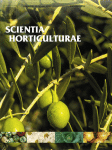Ver ítem
- xmlui.general.dspace_homeCentros Regionales y EEAsCentro Regional Mendoza - San JuanEEA JunínArtículos científicosxmlui.ArtifactBrowser.ItemViewer.trail
- Inicio
- Centros Regionales y EEAs
- Centro Regional Mendoza - San Juan
- EEA Junín
- Artículos científicos
- Ver ítem
Long-term effects of row spacing on radiation interception, fruit characteristics and production of hedgerow olive orchard (cv. Arbequina)
Resumen
In 2008, two experimental plots, oriented NS and EW, respectively, were established in Puebla de Montalbán, Toledo, Spain, at seven row spacings: 2.5, 2.75, 3.25, 3.75, 4.25, 4.75 and 5.0 m, all with same intra-row spacing of 1.3 m. Fruit characteristics (number, size and oil concentration) and an alternate bearing index were evaluated during years 3–11 after planting. Incident and intercepted canopy radiation were simulated with a mathematical model.
[ver mas...]
In 2008, two experimental plots, oriented NS and EW, respectively, were established in Puebla de Montalbán, Toledo, Spain, at seven row spacings: 2.5, 2.75, 3.25, 3.75, 4.25, 4.75 and 5.0 m, all with same intra-row spacing of 1.3 m. Fruit characteristics (number, size and oil concentration) and an alternate bearing index were evaluated during years 3–11 after planting. Incident and intercepted canopy radiation were simulated with a mathematical model. During the first three harvests, fruit characteristics and oil production/tree were not significantly affected by row spacing such that both fruit and oil production/ha were directly related to tree density per ha. Subsequently, individual trees in the closer-spaced hedgerows developed fewer fruits (56 %), larger fruits (15 %) with greater oil concentration (3 %) than the more-spaced trees providing a partial compensation of fruit and oil production/ha. During 8–11 years after planting, when all hedgerows had similar structure, fruit (R2 = 0.86–0.93) and oil (R2 = 0.79–0.92) production/tree were strongly and linearly related to row spacing with differences between orientations that decreased markedly as spacing increased. Whereas fruit production/ha (R2 = 0.97–0.98) retained a linear response across all row widths, oil production/ha remained constant at the three closest spacings (2.50–3.25 m), then decreasing linearly (R2 = 0.84–0.98) to the widest spacing. Differences in oil yield between orientations at close spacing (2.9 and 2.5 t/ha, EW and NS, respectively) were lost at the widest spacing. Fruit but not oil production per orchard area was linearly related with spacing and intercepted radiation. A reduction of 1 m of spacing from 5.0 to 3.25 m increased interception by 12 % and oil production by 0.32 and 0.48 t oil/ha in NS and EW, respectively. When data from the two orientations were normalized and pooled in a single relationship, oil production increased linearly (R2 = 0.89) with interception to a maximum of 65 % (reached in spacing 3.6 m in NS and 3.3 m in EW) of incident radiation revealing the impact of lower transmission of radiation within closely spaced hedgerows.
[Cerrar]

Autor
Gómez del Campo, María;
Trentacoste, Eduardo Rafael;
Connor, David J.;
Fuente
Scientia Horticulturae 272 : 109583 (October 2020)
Fecha
2020
Editorial
Elsevier
ISSN
0304-4238
Formato
pdf
Tipo de documento
artículo
Palabras Claves
Derechos de acceso
Restringido
 Excepto donde se diga explicitamente, este item se publica bajo la siguiente descripción: Creative Commons Attribution-NonCommercial-ShareAlike 2.5 Unported (CC BY-NC-SA 2.5)
Excepto donde se diga explicitamente, este item se publica bajo la siguiente descripción: Creative Commons Attribution-NonCommercial-ShareAlike 2.5 Unported (CC BY-NC-SA 2.5)

